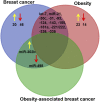Role of MicroRNA Regulation in Obesity-Associated Breast Cancer: Nutritional Perspectives
- PMID: 29141971
- PMCID: PMC5682994
- DOI: 10.3945/an.117.015800
Role of MicroRNA Regulation in Obesity-Associated Breast Cancer: Nutritional Perspectives
Abstract
Breast cancer is the most common malignancy diagnosed in women, and the incidence of breast cancer is increasing every year. Obesity has been identified as one of the major risk factors for breast cancer progression. The mechanisms by which obesity contributes to breast cancer development is not yet understood; however, there are a few mechanisms counted as potential producers of breast cancer in obesity, including insulin resistance, chronic inflammation and inflammatory cytokines, adipokines, and sex hormones. Recent emerging evidence suggests that alterations in microRNA (miRNA) expressions are found in several diseases, including breast cancer and obesity; however, miRNA roles in obesity-linked breast cancer are beginning to unravel. miRNAs are thought to be potential noninvasive biomarkers for diagnosis and prognosis of cancer patients with comorbid conditions of obesity as well as therapeutic targets. Recent studies have evidenced that nutrients and other dietary factors protect against cancer and obesity through modulation of miRNA expressions. Herein, we summarize a comprehensive overview of up-to-date information related to miRNAs and their molecular targets involved in obesity-associated breast cancer. We also address the mechanisms by which dietary factors modulate miRNA expression and its protective roles in obesity-associated breast cancer. It is hoped that this review would provide new therapeutic strategies for the treatment of obesity-associated breast cancer to reduce the burden of breast cancer.
Keywords: adipocyte; breast cancer; dietary components; microRNA; obesity.
© 2017 American Society for Nutrition.
Conflict of interest statement
Author disclosures: RK and DR, no conflicts of interest.
Figures



Similar articles
-
The Interplay Between Obesity and Aging in Breast Cancer and Regulatory Function of MicroRNAs in This Pathway.DNA Cell Biol. 2025 Feb;44(2):55-81. doi: 10.1089/dna.2024.0170. Epub 2024 Dec 9. DNA Cell Biol. 2025. PMID: 39653363 Review.
-
Connecting the dots in the associations between diet, obesity, cancer, and microRNAs.Semin Cancer Biol. 2023 Aug;93:52-69. doi: 10.1016/j.semcancer.2023.05.001. Epub 2023 May 6. Semin Cancer Biol. 2023. PMID: 37156343 Review.
-
Obesity as a Risk Factor for Breast Cancer-The Role of miRNA.Int J Mol Sci. 2022 Dec 10;23(24):15683. doi: 10.3390/ijms232415683. Int J Mol Sci. 2022. PMID: 36555323 Free PMC article. Review.
-
MicroRNAs and other non-coding RNAs in adipose tissue and obesity: emerging roles as biomarkers and therapeutic targets.Clin Sci (Lond). 2019 Jan 3;133(1):23-40. doi: 10.1042/CS20180890. Print 2019 Jan 15. Clin Sci (Lond). 2019. PMID: 30606812 Review.
-
Integrated analysis of mRNA and miRNA profiles revealed the role of miR-193 and miR-210 as potential regulatory biomarkers in different molecular subtypes of breast cancer.BMC Cancer. 2021 Jan 18;21(1):76. doi: 10.1186/s12885-020-07731-2. BMC Cancer. 2021. PMID: 33461524 Free PMC article.
Cited by
-
Identification of an optimized glycolytic-related risk signature for predicting the prognosis in breast cancer using integrated bioinformatic analysis.Medicine (Baltimore). 2023 Sep 1;102(35):e34715. doi: 10.1097/MD.0000000000034715. Medicine (Baltimore). 2023. PMID: 37656998 Free PMC article.
-
Involvement of microRNA in Solid Cancer: Role and Regulatory Mechanisms.Biomedicines. 2021 Mar 29;9(4):343. doi: 10.3390/biomedicines9040343. Biomedicines. 2021. PMID: 33805515 Free PMC article. Review.
-
Overexpression of SKA3 correlates with poor prognosis in female early breast cancer.PeerJ. 2021 Dec 13;9:e12506. doi: 10.7717/peerj.12506. eCollection 2021. PeerJ. 2021. PMID: 34993016 Free PMC article.
-
Biological Role and Clinical Implications of microRNAs in BRCA Mutation Carriers.Front Oncol. 2021 Sep 6;11:700853. doi: 10.3389/fonc.2021.700853. eCollection 2021. Front Oncol. 2021. PMID: 34552867 Free PMC article. Review.
-
The Effectiveness of Metabolic Bariatric Surgery in Preventing Gynecologic Cancer - from Pathophysiology to Clinical Outcomes.J Cancer. 2024 Jan 1;15(4):1077-1092. doi: 10.7150/jca.91471. eCollection 2024. J Cancer. 2024. PMID: 38230225 Free PMC article. Review.
References
-
- Ferlay J, Soerjomataram I, Dikshit R, Eser S, Mathers C, Rebelo M, Parkin DM, Forman D, Bray F. Cancer incidence and mortality worldwide: sources, methods and major patterns in GLOBOCAN 2012. Int J Cancer 2015;136:E359–86. - PubMed
-
- American Cancer Society. Cancer facts and figures. Boston (MA): American Cancer Society; 2016.
-
- Baan R, Straif K, Grosse Y, Secretan B, El Ghissassi F, Bouvard V, Altieri A, Cogliano V; WHO International Agency for Research on Cancer Monograph Working Group. Carcinogenicity of alcoholic beverages. Lancet Oncol 2007;8:292–3. - PubMed
-
- Key J, Hodgson S, Omar RZ, Jensen TK, Thompson SG, Boobis AR, Davies DS, Elliott P. Meta-analysis of studies of alcohol and breast cancer with consideration of the methodological issues. Cancer Causes Control 2006;17:759–70. - PubMed
-
- Economopoulou P, Dimitriadis G, Psyrri A. Beyond BRCA: new hereditary breast cancer susceptibility genes. Cancer Treat Rev 2015;41:1–8. - PubMed
Publication types
MeSH terms
Substances
LinkOut - more resources
Full Text Sources
Other Literature Sources
Medical

